Flashing direction indicators on Jaguar XK
From Trafficators to Flashing indicators.
After the introduction of the XK120 the first open versions (OTS) had been delivered without any form of direction indicators. The Jaguar Saloons of that period had the so-called “Trafficators” (or “Semaphores”) installed.
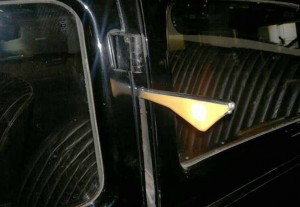 Trafficator on Jaguar 1½ litre Saloon
Trafficator on Jaguar 1½ litre Saloon
By October 1952 most Jaguar XK120 models had switched over to “flashing direction indicators”, although (according some catalogues) “Home Market” versions may have continued without direction indicators. The XK120 with flashing indicators required “combined bulb functions” at front and rear as no dedicated direction indicator lamps had been foreseen in the initial design.
- At the front single filament bulb Lucas 490 side lamps changed to double filament Lucas 513 side lamps with Lucas bulb 361 (12V 6/18W).
- At the rear the existing Tail/Stop lamps Lucas model 488 also received an additional function: the 18W brake filament of the Lucas bulb 361 (12V 6/18W) now also acted as flashing indicator.
This was only possible via the installation of a special Lucas double relay (model DB10) that interrupted the brake light in favour of the flashing indicator function when the direction indicator switch was operated. The other brake light kept its normal function to show that the vehicle was braking.
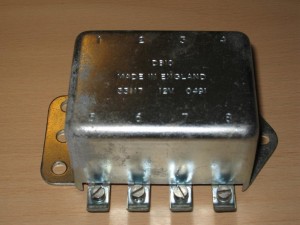 Typical Lucas double relay DB10
Typical Lucas double relay DB10
The combined direction indicator function for front and rear lamps changed in two steps:
- At the front, dedicated Lucas L563 direction indicator lights were fitted late 1954 on the occasion of the introduction of the XK140
- Dedicated rear direction indicator lights only arrived in October 1959 when the XK150 changed over to Lucas L627 rear lights with a separate amber or red (USA) direction indicator lens. At that moment also the double relay DB10 was deleted.
The flasher unit.
In the direction indicator system the role of the flasher unit is crucial. The flasher unit is a switch that (in simple words) interrupts the power supply to the bulbs when the current through the wire heats up a spring and restores the connection again when it cools down and all this in a fraction of a second. The rate of flash is normally between 60 and 120 times per minute.
Although difficult to imagine nowadays, the flashing indicator was a new product in England (and the whole of Europe in fact) after WW2 and first development dated from 1949 (Bosch of Germany). In the UK it took until early 1953 before Lucas could supply such units (the FL2 flasher unit) to the British automotive industry.
Introduction of flashers on Jaguar XKs
First flasher units for 1952 Jaguars including XK 120 have been delivered by the Tung-Sol company of Newark, New Jersey, USA. This company (famous for its automotive bulbs but even more for radio tubes) made the first steps towards a “flashing turn devise” in the 1920s. From the 1940s onwards most US car models had these flasher units.
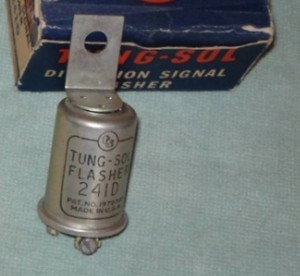
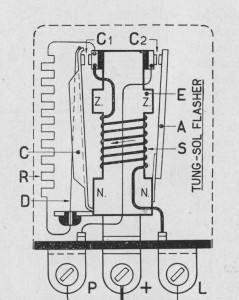 Original Tung-Sol 241D
Original Tung-Sol 241D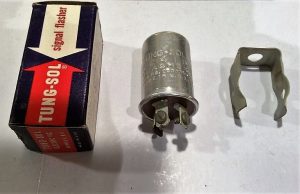
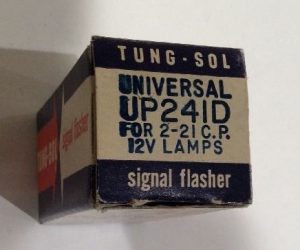 Later version
Later version
The Tung-Sol flasher unit is a complex devise using both “thermal expansion” of the metal arms as well as “electro-magnetism” to open and close the points.
The flasher used by Jaguar was part number Tung-Sol 241D which is a flasher units suitable for switching 2 x 21W (total 42W) including a (“Trafficator”) warning light. Jaguar used in that period 2 x 18W bulb power plus a 2.2W warning light in the instrument panel (total power about 38W).
Note the following Service Bulletin 112 of October 1952: “Cars scheduled for export are fully wired for flashing indicators and have relay units fitted. Owing to shortage of supplies, Tung-Sol unit part number 241D is not included for certain countries, and it is the responsibility of the Distributor to ensure that unit is obtained locally and fitted prior to delivery”.
The Jaguar part number for the Tung-Sol 241D flasher was C5230.
The Tung-Sol flasher has three screw contacts at the bottom marked + (for battery), L (for direction indicator lamps to be switched) and P (for pilot or warning light). The flasher had a vertical bracket with mounting hole. Also note that the early Tung-Sol flashers had the product data printed in black on the aluminium can.
Change-over to Lucas flashers
Lucas had developed in the meantime their first flasher units. The FL2 (Lucas part number FL35002) had been introduced early 1953. A revised version model FL3 arrived late 1953 with Lucas part number 35003/A which was consequently used in the XK120 production. Note that Jaguar part number remained C5230.
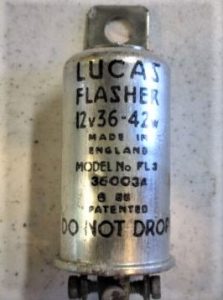
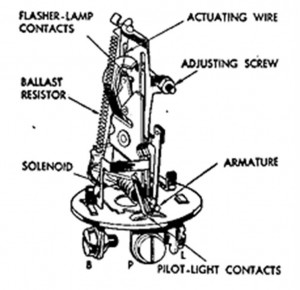 Lucas FL 3 35003A
Lucas FL 3 35003A
The Lucas FL3 flasher unit is basically identical to the earlier Tung-Sol version. Also note the exact details of the (copied) screw connections. Even the marking was identical apart from + which changed into B (for battery); remember Jaguars had positive earth. Also Lucas started with printed product data on the outside of the aluminium flasher housing. This flasher also had a vertical bracket with mounting hole.
The Lucas FL3 (35003A) was continued for the year 1954 when the Jaguar XK140 was introduced and remained standard fitment until early 1957. The XK 140 received dedicated direction indicator lamps at the front (Lucas L563) and thus the Lucas 513 side lamps changed from double filament to single filament bulb holders with Lucas bulb 207 (12V 6W). We note that all Jaguar XK 140s had the FL3 as standard equipment.
From FL3 to FL5 flasher units
Early 1957 the FL3 was replaced by the FL5 flasher unit (Lucas part number 35010A). Jaguar part number remained (again) C5230. The internal construction had changed and the aluminium housing had a larger diameter but it was shorter than the FL3.
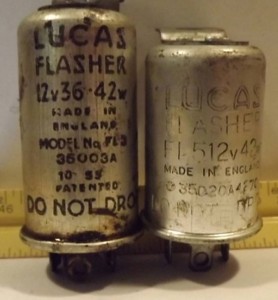 Comparison FL3 versus FL5 (courtesy Marvin Moore)
Comparison FL3 versus FL5 (courtesy Marvin Moore)
The FL5 remained the standard version for many years until it was replaced in the 1980s by the 8FL version.
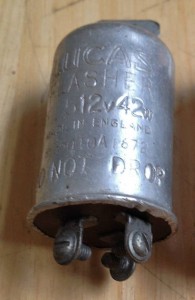
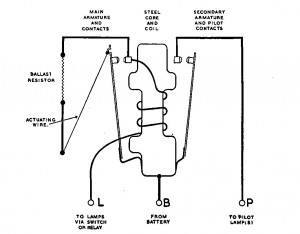 FL5 flasher 35010A
FL5 flasher 35010A
The FL5 flashers kept the 3 screw connections and the marking was still B, L and P. But Lucas changed from printed to stamped product data on the outside of the aluminium flasher housing. The 35010 flasher continued the vertical bracket with mounting hole.
The Jaguar XK150 started life in February 1957 with the new Lucas FL5 flasher. It continued the direction indicator lamps (front and aft) of the Jaguar XK140 until dedicated rear direction indicator lights arrived in October 1959. The XK150 changed over to Lucas L627 rear lights with a separate amber (or red for USA) direction indicator lens. At this moment also the double relay DB10 was deleted.
Overview of flasher versions for XK120, 140 and 150.
Lucas Flasher product range
Lucas extended their range of flasher units gradually over the years. In fact only the FL3 and FL5 models are of interest to the Jaguar XK owner. As far as originality is concerned, the FL3 version is by now almost impossible to find but the early FL5 version with 3 screw contacts can still be found as it has been manufactured until the 1970s in large quantities.
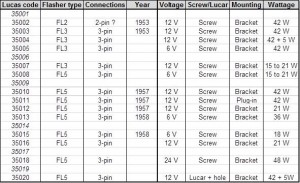 Survey of Lucas FL3 and FL5 flashers
Survey of Lucas FL3 and FL5 flashers
Lucas introduced the “Lucar” connectors (replacing the screw contacts) in 1960. These flasher versions are (functionally) identical to the earlier 35010 version, apart from the Lucar connections at the bottom. We are also looking for a vertical bracket with mounting hole, because there are also other versions without a vertical bracket, e.g. Lucas 35011. These flashers require a separate mounting clip and also sometimes have a special connector which looks very similar to a 3 pin bulb holder as used for Sealed Beam lamps in the 50s and 60s. This construction allows for a quick replacement of a defective flasher unit. Note that in some cases the connector block is fixed to the car body with a screw (RH photo below).

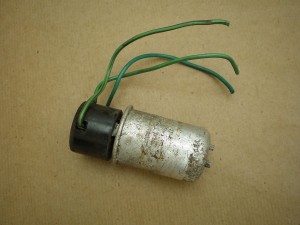
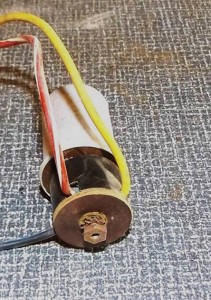
hello Bob. I was under the impression that US delivered 120s all had the Tung-Sol 241D flasher units installed. It wasn’t until the launch of the 140 that the FL3 Lucas unit was supplied. I note that the image you post of the FL3 appears to have a 1955 date printed on the drum. please advise thank you
Bob:
Wondered if you might know where I could fine either the Lucas FL3 or a Tung-Sol 241D unit?
Thanks, Cliff
Hi, This web spot is very helpful- thanks. I have an XK140 and the indicator switch on the dashboard to centring itself too quickly. I have pulled it apart and can see that there should be a plug of wadding or something that can be adjusted from the rear to create the resistance to slow down the indicator. But what is this material? Is it like a carbon brush that is wound in to create the resistance to slow down the indicator? I do not need a full new unit, just this specific part of the unit. Thanks for any advise.
Regards, Tony Johnson New Zealand